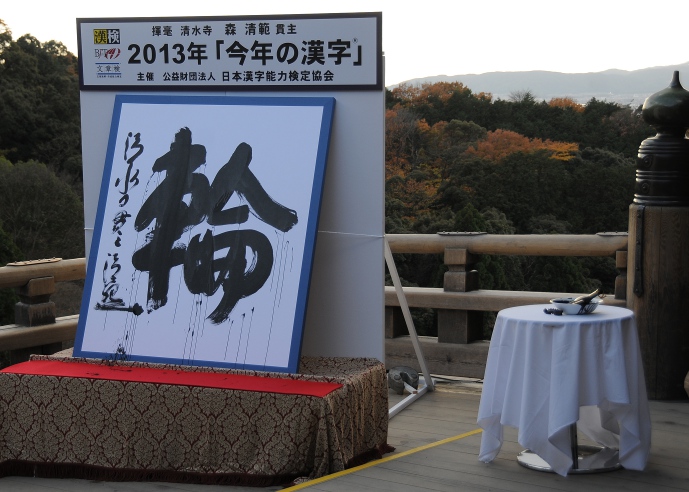Towards the end of the year, people all over the world like to reminiscence about the year that has passed. Of the Year is an important phrase in this time, and it is added to words like employee, woman, man, person, word, book, movie,… So, let me, without any further ado, present to you the Kanji of the Year 2013: 
It means ring or wheel and is pronounced as rin or wa, depending on the context. The main reason this character was chosen was that this year, Tokyo has won the bid for the Summer Olympic Games in 2020, something the Japanese are extremely proud of.
Interestingly, choosing a Kanji of the Year is not something invented 1000 years ago! The first such event dates back only to 1995, yes, that’s not even 20 years; this ceremony must feel like the baby amongst all the others celebrated in Japan… 😉 However, it is a very nice ceremony sponsored and organised by the Japanese Kanji Proficiency Society, a private organisation that encourages the use and knowledge of Kanji. People are invited to send in their choice for the Kanji of the Year, and the one with the most votes (this year 9,518 out of 170,290 votes) is then announced, that is, written on a large white board, by the head priest of Kiyomizu temple in Kyoto each year on Kanji Day, December 12.  I went there with a friend to see the ceremony, and it was virtually impossible. At 11:30, the best spots were already taken by journalists, and the not so good spots were guarded by a private security company that told people to move on… We finally secured a place on a viewing platform a little further away and waited in the cold until the ceremony began at 2 pm. Once again, everything was over very quickly. The head priest came, and quickly wrote down the kanji with a brush as thick as my arm (see the first photo above). After a short wait so all journalists could take their pictures, the board was brought into the temple where a small ceremony was conducted. Afterwards, the board was taken out again to take more pictures with the head priest and other celebrities (this was the time for me to sneak up and take my close ups) and then, after maybe half an hour, even before all the journalists had left, everything was taken away and cleaned up again. The whole event was broadcast live on TV; there were even two TVs set up at the temple so people could watch the ceremony at least second hand, and my friend, a distinguished but not unapproachable looking foreigner, was interviewed twice and asked for his opinion on the choice.
I went there with a friend to see the ceremony, and it was virtually impossible. At 11:30, the best spots were already taken by journalists, and the not so good spots were guarded by a private security company that told people to move on… We finally secured a place on a viewing platform a little further away and waited in the cold until the ceremony began at 2 pm. Once again, everything was over very quickly. The head priest came, and quickly wrote down the kanji with a brush as thick as my arm (see the first photo above). After a short wait so all journalists could take their pictures, the board was brought into the temple where a small ceremony was conducted. Afterwards, the board was taken out again to take more pictures with the head priest and other celebrities (this was the time for me to sneak up and take my close ups) and then, after maybe half an hour, even before all the journalists had left, everything was taken away and cleaned up again. The whole event was broadcast live on TV; there were even two TVs set up at the temple so people could watch the ceremony at least second hand, and my friend, a distinguished but not unapproachable looking foreigner, was interviewed twice and asked for his opinion on the choice.
I enjoyed being there, despite the long wait and my frozen toes afterwards. I’m not sure if I’d want to come again next year as I hate being cold, but having my own photos of the event is certainly a nice thing.
